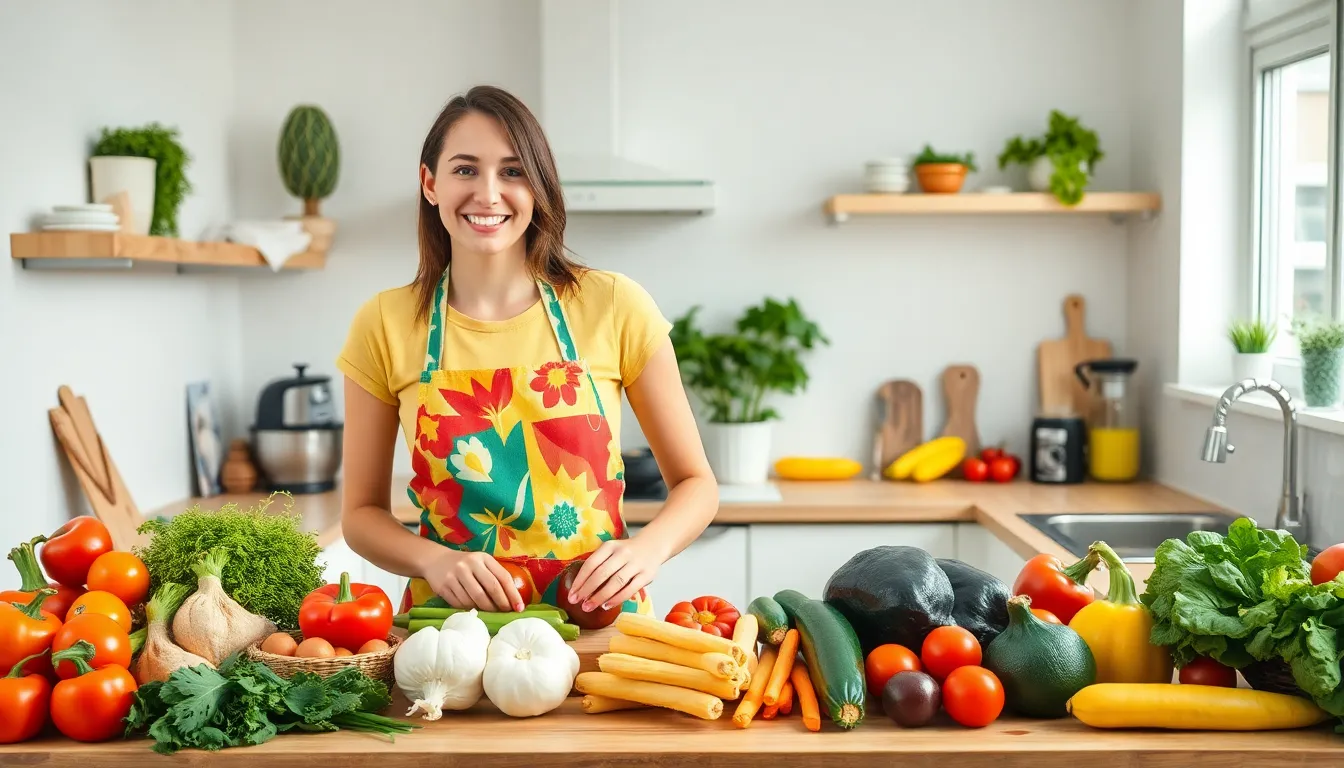Cooking is an essential life skill that can transform everyday meals into delightful experiences. Whether someone is a novice in the kitchen or looking to brush up on their techniques, mastering basic cooking skills can boost confidence and creativity. From chopping vegetables to understanding cooking methods, these foundational skills lay the groundwork for culinary success.
In a world where convenience often takes precedence, knowing how to cook can lead to healthier eating habits and more enjoyable dining experiences. It allows individuals to explore new cuisines and flavors while also saving money. With the right guidance, anyone can learn to whip up delicious dishes that impress family and friends. Embracing these basic cooking skills opens the door to a lifetime of culinary adventures.
Table of Contents
ToggleUnderstanding Basic Cooking Skills
Basic cooking skills form the foundation for culinary success and enable individuals to create a variety of dishes. Mastering these fundamental techniques enhances confidence and encourages creativity in meal preparation.
Key Techniques
- Chopping: Chopping vegetables, herbs, and proteins into uniform pieces ensures even cooking and enhances presentation.
- Sautéing: Sautéing involves cooking food quickly in a small amount of oil over high heat. This method retains flavors and textures.
- Boiling: Boiling is the method of cooking food in water at high temperatures. It’s essential for pasta and vegetables.
- Baking: Baking utilizes dry heat in an oven. This technique is crucial for making bread, pastries, and casseroles.
Essential Skills
- Knife Skills: Proper knife techniques improve safety and efficiency in food preparation. Mastering various cuts, such as julienne and dice, is vital.
- Seasoning: Understanding how to season dishes with salt, herbs, and spices enhances flavors and overall appeal.
- Cooking Timings: Knowing cooking times for different ingredients prevents overcooking or undercooking, ensuring optimal taste and texture.
- Food Safety: Basic knowledge of food safety, including proper storing, handling, and cooking temperatures, is crucial to prevent foodborne illnesses.
Cooking Methods
| Cooking Method | Description |
|---|---|
| Grilling | Cooking food over direct heat for flavor. |
| Steaming | Cooking food with steam to retain nutrients. |
| Roasting | Using dry heat to cook food evenly. |
| Braising | Slow cooking in liquid for rich flavors. |
Incorporating these basic cooking skills into daily routines allows individuals to prepare nutritious meals, experiment with international cuisines, and enjoy the culinary process. Developing these skills enhances the overall dining experience at home.
Importance of Basic Cooking Skills


Basic cooking skills significantly enhance one’s ability to prepare healthy and delicious meals. Acquiring these skills fosters self-sufficiency and opens up a world of culinary possibilities.
Health Benefits
Basic cooking skills contribute to better health. Home-cooked meals typically contain fresher ingredients, allowing for precise control over nutrition and portion sizes. Cooking at home enables individuals to avoid excessive sugar, salt, and unhealthy fats often found in processed foods. Furthermore, adopting varied cooking methods, such as steaming and roasting, preserves essential nutrients in vegetables and proteins, promoting an overall healthier diet.
Economic Advantages
Basic cooking skills also lead to economic benefits. Preparing meals at home proves more cost-effective than frequently dining out or relying on takeout. By purchasing raw ingredients in bulk and utilizing leftovers creatively, individuals can minimize food waste and reduce grocery costs. Additionally, developing cooking skills enables experimentation with diverse cuisines and ingredients, fostering a greater appreciation for food and its preparation while potentially leading to healthier spending habits in the long run.
Essential Tools for Basic Cooking Skills
Having the right tools streamlines the cooking process and enhances efficiency. Essential kitchen utensils and cooking appliances form the backbone of successful culinary endeavors.
Kitchen Utensils
- Chef’s Knife: A versatile knife for chopping, slicing, and dicing various ingredients. It improves precision and speed in meal prep.
- Cutting Board: Provides a stable surface for food preparation. Different boards can prevent cross-contamination, especially between raw meat and vegetables.
- Measuring Cups and Spoons: Ensure accurate measurements for recipes, helping maintain balance in flavors and textures.
- Mixing Bowls: Essential for combining ingredients, these bowls come in various sizes to accommodate different quantities.
- Wooden Spoon: Ideal for stirring and mixing without scratching cookware. It helps distribute flavors evenly in dishes.
- Tongs: Perfect for flipping and serving hot foods, tongs provide safe handling without damaging delicate items like fish.
- Peeler: Necessary for removing skins from fruits and vegetables, helping to prepare ingredients quickly and efficiently.
- Whisk: Used for beating eggs and mixing batters, a whisk incorporates air, improving texture in baked goods.
Cooking Appliances
- Stovetop: Provides direct heat for various cooking methods, such as boiling, sautéing, and simmering. Gas or electric models are common in most kitchens.
- Oven: Essential for baking, roasting, and broiling. Ovens vary in type, including conventional, convection, and toaster ovens, each offering unique benefits.
- Microwave: Speeds up cooking and reheating processes. Microwaves are useful for defrosting ingredients or cooking quick meals.
- Blender: Ideal for smoothies and purees, blenders can also chop and mix ingredients, making them versatile tools for various culinary tasks.
- Food Processor: Saves time by chopping, slicing, and shredding ingredients efficiently. It’s particularly useful for meal prep and creating sauces.
- Slow Cooker: Allows for hands-off cooking; simply add ingredients in the morning and enjoy meals later. It’s perfect for soups, stews, and casseroles.
- Instant Pot: Combines pressure cooking, sautéing, and slow cooking functionalities in one appliance, making meal preparation quicker and simpler.
- Toaster: Essential for quickly toasting bread and cooking simple breakfasts. Modern toasters often include features for bagels and frozen items.
These essential tools enable home cooks to master fundamental cooking skills, fostering confidence and creativity in the kitchen.
Core Techniques of Basic Cooking Skills
Basic cooking skills encompass essential techniques that greatly improve culinary proficiency. Mastering knife skills and various cooking methods lays a strong foundation for successful meal preparation.
Knife Skills
Knife skills form the cornerstone of food preparation. Mastering proper knife techniques ensures efficiency and safety in the kitchen. Key skills include:
- Chopping: Chopping vegetables, herbs, and meats into uniform pieces ensures even cooking.
- Slicing: Slicing ingredients like meat and bread requires precision to enhance presentation and cooking consistency.
- Dicing: Dicing involves cutting food into small, cube-like pieces, commonly used in salads and stir-fries.
- Mincing: Mincing garlic, herbs, and spices releases essential oils, maximizing flavor in dishes.
Effectively utilizing different knives, such as chef’s knives and paring knives, improves efficiency and safety. Regular practice of these skills not only increases speed but also boosts confidence in the kitchen.
Cooking Methods
Understanding various cooking methods expands a cook’s repertoire and skill set. Each cooking method influences flavor, texture, and nutrition in different ways. Key cooking methods include:
- Sautéing: Sautéing involves cooking food quickly in a small amount of fat, enhancing natural flavors while maintaining texture.
- Boiling: Boiling cooks food in water or broth and is essential for pasta, grains, and vegetables.
- Baking: Baking applies dry heat to foods like bread and pastries, creating appealing textures and flavors.
- Grilling: Grilling imparts a smoky flavor and char to meats and vegetables, ideal for outdoor cooking.
- Steaming: Steaming cooks food using hot steam, preserving vitamins and minerals, especially in vegetables.
- Roasting: Roasting involves cooking food in an oven at high temperatures, resulting in rich flavors and crispy textures.
- Braising: Braising combines slow-cooking and moisture, perfect for tenderizing tough cuts of meat.
Familiarity with these methods enhances a cook’s versatility, enabling them to explore diverse cuisines and create a variety of dishes.
Common Mistakes to Avoid
Cooking can be rewarding, but avoiding common mistakes is crucial for successful outcomes. Here are several pitfalls to sidestep:
- Neglecting Knife Skills
Neglecting proper knife techniques can lead to unevenly chopped ingredients and increase the risk of accidents. Ensuring knife skills are mastered promotes safety and efficiency.
- Overseasoning Dishes
Over seasoning can overpower the natural flavors of ingredients. It’s essential to start with small amounts of salt, herbs, and spices, adjusting as needed for balanced flavor.
- Ignoring Cooking Timings
Ignoring specified cooking times often results in overcooked or undercooked food. Following timing guidelines for various cooking methods ensures optimal texture and taste.
- Skipping Food Safety Practices
Skipping food safety measures can lead to foodborne illnesses. Always wash hands, sanitize surfaces, and store ingredients at the correct temperatures.
- Using Inappropriate Cooking Methods
Using the wrong cooking methods can alter the desired outcome of a dish. Understanding which technique suits a particular ingredient is vital for achieving the best results.
- Failing to Prepare Ingredients Before Cooking
Failing to prep ingredients beforehand can disrupt workflow and hinder efficiency. Having all ingredients measured and ready allows for a more organized cooking process.
- Rushing the Process
Rushing through cooking can lead to mistakes and overlooked details. Taking time to focus on each step ensures a more successful dish.
- Not Tasting During Cooking
Not tasting dishes throughout the cooking process can cause flavor discrepancies. Tasting at various stages allows for proper adjustments to seasoning and cooking techniques.
- Overcrowding Cookware
Overcrowding pans or trays can impede even cooking and browning. It’s essential to give ingredients ample space to cook properly.
- Disregarding Recipe Instructions
Disregarding specific recipe guidelines can lead to unsatisfactory results. Following instructions closely, especially for baking, ensures consistency and success.
Embracing basic cooking skills opens the door to a world of culinary possibilities. It empowers individuals to create nutritious meals while fostering creativity and confidence in the kitchen. With the right techniques and tools at their disposal, anyone can transform simple ingredients into delicious dishes.
By mastering essential skills like knife techniques and various cooking methods, home cooks can elevate their meals and enjoy healthier eating habits. Avoiding common mistakes ensures a more enjoyable cooking experience, paving the way for culinary success.
Ultimately, the journey of learning to cook is not just about preparing food; it’s about nurturing a lifelong skill that enriches daily life and brings joy to the table.


